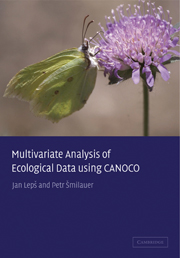Book contents
- Frontmatter
- Contents
- Preface
- 1 Introduction and data manipulation
- 2 Experimental design
- 3 Basics of gradient analysis
- 4 Using the Canoco for Windows 4.5 package
- 5 Constrained ordination and permutation tests
- 6 Similarity measures
- 7 Classification methods
- 8 Regression methods
- 9 Advanced use of ordination
- 10 Visualizing multivariate data
- 11 Case study 1: Variation in forest bird assemblages
- 12 Case study 2: Search for community composition patterns and their environmental correlates: vegetation of spring meadows
- 13 Case study 3: Separating the effects of explanatory variables
- 14 Case study 4: Evaluation of experiments in randomized complete blocks
- 15 Case study 5: Analysis of repeated observations of species composition from a factorial experiment
- 16 Case study 6: Hierarchical analysis of crayfish community variation
- 17 Case study 7: Differentiating two species and their hybrids with discriminant analysis
- Appendix A Sample datasets and projects
- Appendix B Vocabulary
- Appendix C Overview of available software
- References
- Index
11 - Case study 1: Variation in forest bird assemblages
Published online by Cambridge University Press: 09 February 2010
- Frontmatter
- Contents
- Preface
- 1 Introduction and data manipulation
- 2 Experimental design
- 3 Basics of gradient analysis
- 4 Using the Canoco for Windows 4.5 package
- 5 Constrained ordination and permutation tests
- 6 Similarity measures
- 7 Classification methods
- 8 Regression methods
- 9 Advanced use of ordination
- 10 Visualizing multivariate data
- 11 Case study 1: Variation in forest bird assemblages
- 12 Case study 2: Search for community composition patterns and their environmental correlates: vegetation of spring meadows
- 13 Case study 3: Separating the effects of explanatory variables
- 14 Case study 4: Evaluation of experiments in randomized complete blocks
- 15 Case study 5: Analysis of repeated observations of species composition from a factorial experiment
- 16 Case study 6: Hierarchical analysis of crayfish community variation
- 17 Case study 7: Differentiating two species and their hybrids with discriminant analysis
- Appendix A Sample datasets and projects
- Appendix B Vocabulary
- Appendix C Overview of available software
- References
- Index
Summary
The primary goal of the analyses demonstrated in this case study is to describe the variability of bird communities, related to the differences in their habitat.
The data set originates from a field study by Mirek E. Šálek et al. (unpublished data) in Velka Fatra Mts. (Slovak Republic) where the bird assemblages were studied using a grid of equidistant points placed over the selected area of montane forest, representing a mix of spruce-dominated stands and beech-dominated stands. There was a varying cover of deforested area (primarily pastures) and the individual quadrats differed in their altitude, slope, forest density, cover and nature of shrub layer, etc. (see the next section for description of environmental variables). The primary data (species data) consist of the number of nesting pairs of individual bird species, estimated by listening to singing males at the centre points of each quadrat. The data values represent an average of four observations (performed twice in each of two consecutive seasons).
Data manipulation
The data are contained in the Excel spreadsheet file named birds.xls. This file has two sheets. We will use the data contained in the first sheet (named birds), where the bird species observed in only one of the quadrats were omitted (the full data are available in the other sheet, labelled birds-full). Note that the birds sheet contains both the species data (average abundance of individual bird species) and the environmental data (description of habitat characteristics for the particular quadrat).
- Type
- Chapter
- Information
- Multivariate Analysis of Ecological Data using CANOCO , pp. 168 - 182Publisher: Cambridge University PressPrint publication year: 2003



